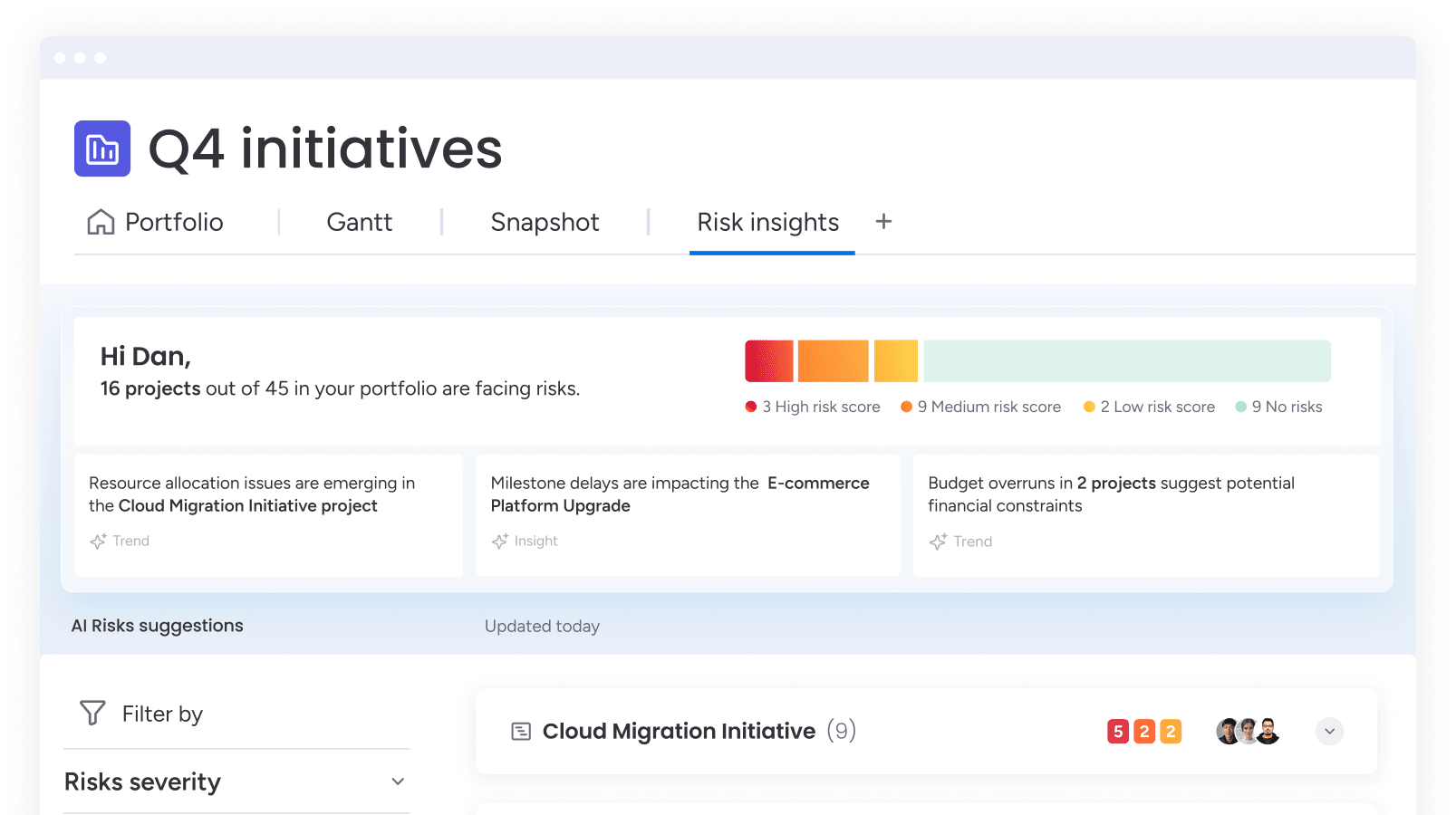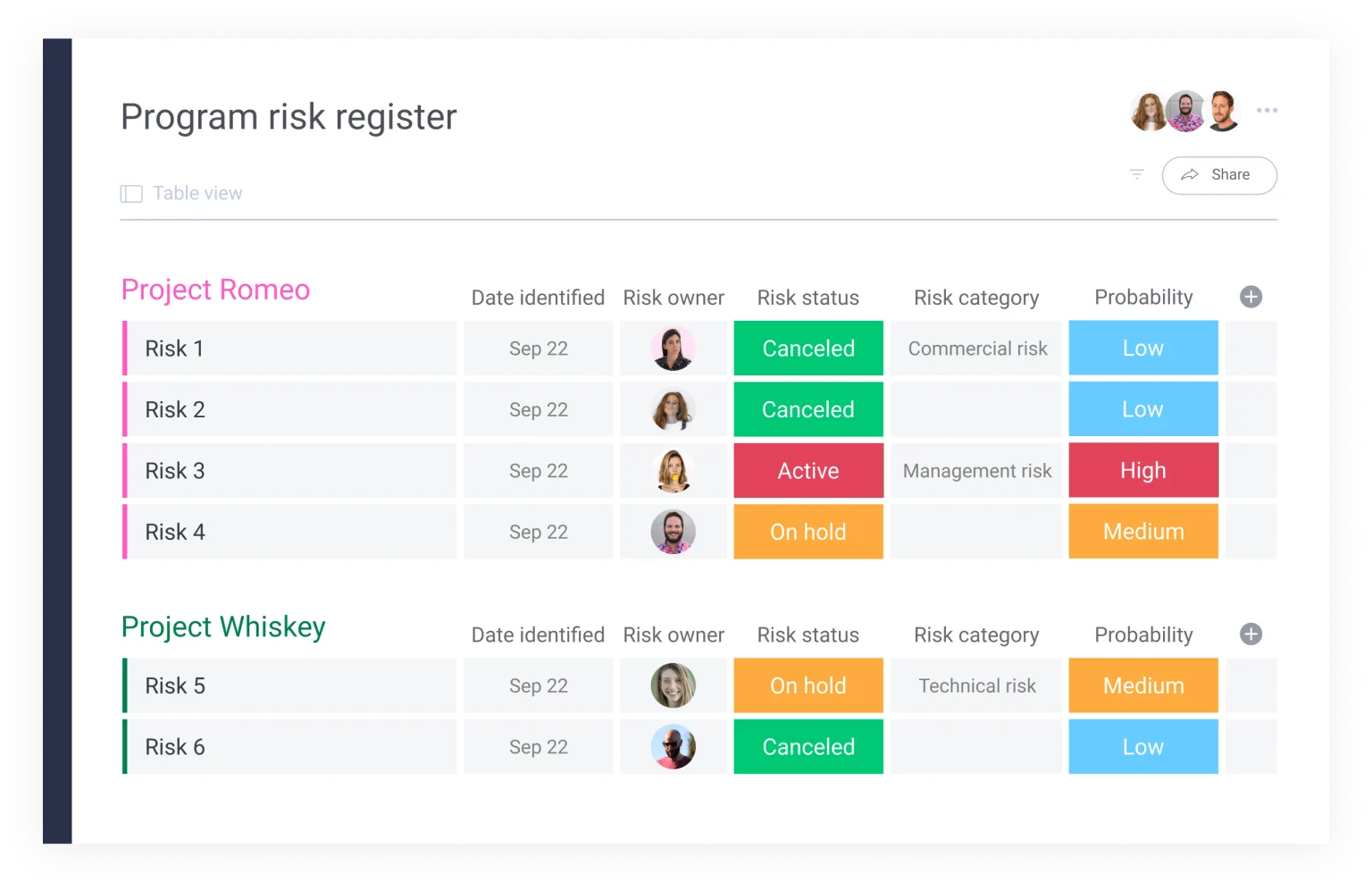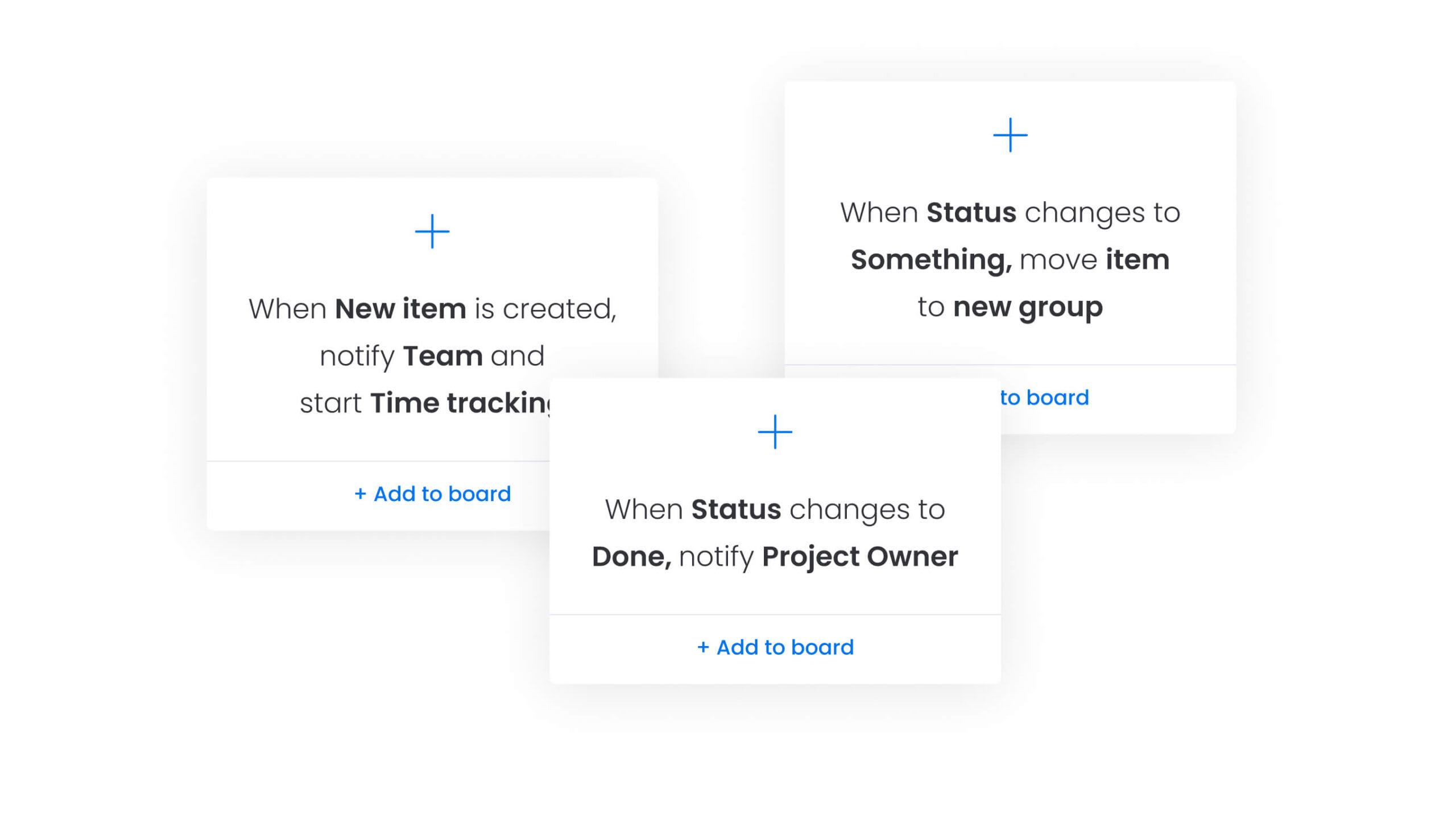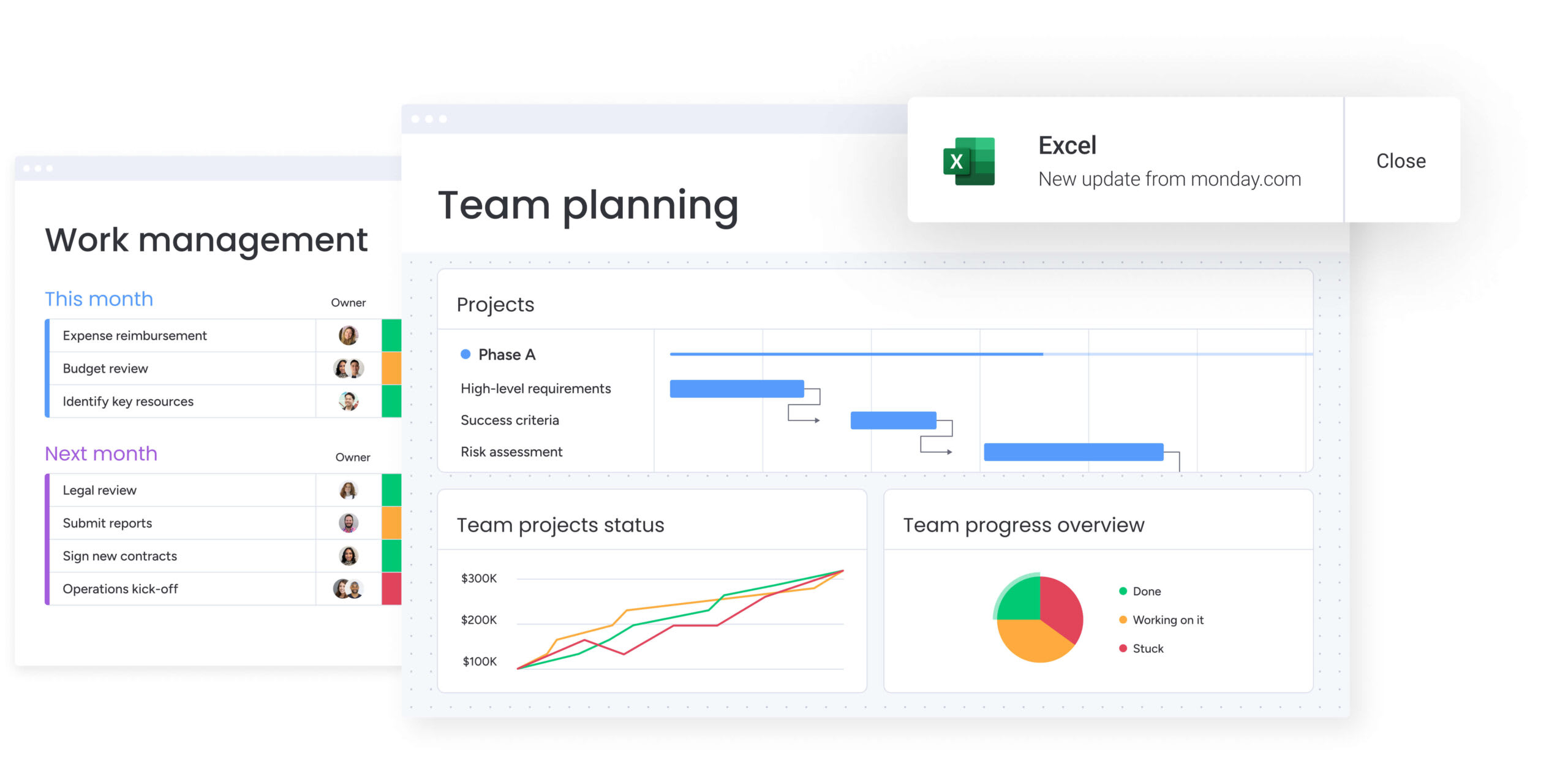Trying to run a business or manage a large project can often feel like walking a tightrope. One wrong step or a single bad decision can have a ripple effect that derails all your hard work.
Of course, you don’t have to go blindly into projects without any idea of the potential risks involved. That would be like planning to walk a tightrope walk without checking the weather forecast or wearing a harness. Project risk management helps you identify all possible risks, figure out the worst ones, and start taking action proactively to deal with them.
In this article, we’ll take a closer look at risk management and show you how to identify, monitor, and mitigate risks for your project using tools like monday work management to confidently complete projects.
Get startedWhat is project risk management?
Risk management is a concept within project management that refers to the practice of identifying, evaluating, prioritizing, mitigating, and preventing project risks so you can complete it without major interruptions.
The idea with risk management is to predict and avert disaster before it happens so you reach your goals without issue.
In project management, there are risks of varying degrees, from natural disasters to technology failures. In risk management, all levels of risk are brought up and assessed and then prioritized according to how likely they are to occur and the potential impact they can have on an outcome.
Who is responsible for risk management?
Risk management is more than just one person’s job. Often, there’s a risk manager or risk coordinator who oversees processes and is responsible for managing individual risk. However, all project stakeholders are responsible for identifying risks.
High-level risks may be addressed during the concept phase conducted before a project’s launch, alongside scope and objective clarification. At this stage, project owners or sponsors will define the benefits the final project will deliver alongside the degree of risk they’re willing to tolerate.
More risks are identified throughout a project’s lifecycle, such as during the initiation and planning stages as well as the execution, monitoring, and control phases.
Why is risk management important for business projects?
Risk management allows teams to complete projects successfully. By being aware of potential issues and taking precautions, businesses can save a lot of time and money in the long run.
Some benefits of the risk management process include:
- Providing a more predictable project outcome by clearly identifying and planning for risks so that they’re less likely to derail the project
- Increasing stability of project operations by providing clear ownership for risk items and corresponding responses
- Addressing possible regulatory issues by creating a formal plan ahead of time along with any relevant paperwork that might be required
- Decreasing legal liability and avoiding possible litigation by showcasing a formal plan to both mitigate and prevent risk to prevent negligence
- Compliance with regulatory or industry requirements by proactively identifying all possible risks and doing proper research at the local, state, and federal levels
What’s the difference between positive risk and negative risk?
Not all risk is bad risk. Sure, risk is mostly associated with being negative but there are positive risks as well.
Negative risk implies a potential unwanted action that acts as a threat to a project’s success, such as:
- A project is delayed
- The budget is drastically exceeded
- Teams are unable to complete their work on time
Positive risks are exactly the opposite and have the potential to affect the project in beneficial ways, for example:
- The project is completed early
- A project gets more customers than expected
- New opportunities are discovered along the way
Whether positive or negative, it’s important to be prepared for all types of risks ahead of time. Positive risks, if not accounted for early on, can turn into negative risks if your team isn’t prepared with a plan on how to handle them.
6 steps for a successful risk management process
The risk management process is an iterative process involving key steps like identifying, analyzing, prioritizing, assigning ownership, and planning. Below, we’ll look at each element of the risk management process in this section.
1. Risk identification
Risk identification is a crucial step in the risk management plan where you identify and record new potential risks in a risk register. In this stage, there’s often a brainstorming session where you think of all the things that can go sideways and take note of them in a risk breakdown structure. These potential risks should be based on information such as past projects, research, and unlikely scenarios.
The bulk of the risk identification process happens at the beginning of the project, but it’s important to remember that it’s an ongoing process. New risks can present themselves all the time and need to be constantly identified, analyzed, and planned for. And they are especially difficult to find the larger the organization gets, which is why enterprise risk management is so crucial.
2. Risk analysis
After identifying risks, it’s time to analyze them. Risk analysis is the process of examining how your project’s outcomes and objectives could change due to the impact of risk events. In other words, it determines the likelihood of a risk occurring and takes it a step further to measure risk impact, risk exposure, and set a risk occurrence time frame.
The 2 major types of risk analysis are qualitative and quantitative:
- Qualitative risk analysis determines every possible outcome for a project and gives them a rating based on a general scale you’ve agreed upon as a team, such as high, medium, and low
- Quantitative risk analysis takes the qualitative analysis up a notch by adding numerical values to your assessments through probability, such as on a 0-100% scale, and impact may be portrayed as a dollar value, delay time, or another measure
Pro tip: want to have AI analyze all your risks? Check out our new features in our guide to AI-powered risk management.

3. Risk prioritization
Very few risks are created equal, so it’s crucial to prioritize them. Some risks require more attention because they have the potential to derail your entire project while others are important but less threatening and can be put into a different category.
Finally, there are risks that have little to no impact whatsoever. Since they don’t affect the project’s budget or schedule, they are often just monitored to ensure nothing changes.
4. Risk ownership
Ownership is a critical element of the risk management process that shouldn’t be taken lightly. A risk owner should be someone who’s familiar with the type of risk or has experience handling a similar situation in the past. If the risk happens, it will be their responsibility to lead the charge toward resolving it.
Identifying and assigning risk owners is a good way to keep multiple sets of eyes on various risks so that one person doesn’t get overwhelmed. It will also help make sure that there’s always someone on top of the action plan when working towards resolving it so that nothing falls through the cracks.
5. Risk response
The next step is to build out your risk response plan. In a risk management plan, you’ll determine the response strategy for each risk, ideally corresponding to how it’s prioritized. Some common risk management strategies include:
- Risk avoidance: Avoid the risk, so that its probability of occurring is next to nil
- Risk mitigation: Mitigate the risk, so your project doesn’t feel too strong an impact
- Risk transfer: Share the risk by transferring to a third party of some kind
- Risk acceptance: Accept the risk by choosing not to resolve, share, or mitigate it
A risk owner will typically be the first to act on the outlined risk mitigation strategy. It’s often their role to also communicate the uncertain event and any corresponding actions taken to both the team and any key stakeholders.
6. Risk monitoring and control
Unleashing the fury of your risk management process onto potential risks isn’t complete without some form of tracking system in place. This is especially important for larger risks that are ongoing and require long-term oversight.
The risk owner should monitor the risk and track it until there’s a resolution or until the project’s completion. Usually, this comes in the form of risk meetings or regular risk updates via project risk management software like monday work management.
The most important element of risk monitoring is transparency. Keeping everyone on the same page by monitoring and controlling risks is the first priority for a great risk management process.
Get startedCommon types of project risks
Before you can take steps to minimize risks, you need to figure out what could go wrong with your project. It’s a lot easier when you know what you’re looking for. Below, we’ll look at some common project risks teams often encounter.
- Scope creep: When a project isn’t planned accurately at the start or new tasks are continuously added on, leading to backups and delays
- Financial risks: Increasing or changing costs, incorrect budgeting, or not estimating cost correctly can put a financial straight on a project
- Operational risks: When something impacts the flow or running of your businesses, such as shipping or supply chain
- Inadequate scheduling: If all team members aren’t on the same page when it comes to the project timeline, it can lead to risking that your project not being done in time
- External risks: Sometimes, even with a well-laid plan, risks can arise from external factors like environmental matters, supply chain issues, changing laws and regulations, labor disputes, and others
- Strategic risks: Mistakes in strategizing, like not doing enough competitor research, using the wrong work tools, or selecting the wrong project management methodology can lead to delays in a project
- Communication problems: When teams don’t communicate well, collaboration takes a hit, so it’s essential to select the right project management collaboration platform like monday work management to facilitate smooth communication
Tips and best practices for successful risk management
Aside from building a foolproof risk management plan, there are a few best practices you can implement to make sure your team is ready to handle any risk that comes their way. Here are a few key tips for successfully managing risks:
- Review your risk management plan regularly to see if anything needs to be updated as a project progresses
- Make sure all relevant team members and stakeholders are on board and understand a project’s potential risks and the plan to handle them
- Use historical data and preview project experience to learn from past mistakes and apply that to your risk management processes on future projects going forward
- Schedule frequent risk assessments throughout a project’s lifecycle or whenever significant changes occur
- Implement a risk register to track and prioritize threats, such as a project management platform that will allow you to easily visualize, organize, and manage risks
monday work management has your back for managing risks
Managing risks requires a lot of visibility and transparency. The best way to guarantee your risk management process is transparent is by adopting a reliable project management platform to handle all the tasks that come with handling risks. monday work management offers complete visibility into your risk management platform with an interface that’s simple and easy to use.
With monday work management, teams can get a handle on various stages of the risk management process while working together collaboratively. Thanks to various communication tools in the platform, you’ll never feel like risks are creeping up to surprise you. Here’s a look at some of monday work management’s key features that make it ideal for risk management.
Customize your risk register

Start cataloging your risks using our project risk register template. Anyone on the project team can identify, flag, and add to the risk issue log board, making it incredibly easy to measure risk probability and determine its corresponding owner. It also shows probability calculations, categories, and risk status, so every project management professional and risk manager has full visibility.
Automated communication and collaboration

With monday work management, your team can always stay in the know with automated communication and collaboration features. Create your own no-code automations to get instantly notified when a risk status gets updated, when task responsibilities change, or set reminders to keep tabs on your highest priority risks.
Monitor projects closely with real-time dashboards and integrations

monday work management offers over 200 app integrations with popular work tools so that you can easily sync data from multiple sources to keep your team up-to-date. When every decision-maker has access to real-time data, your company starts making better long-term decisions as a whole.
Get startedDon’t leave project success up to chance
A whole host of things can impact or derail even the least complex projects. From cyberattacks to changes in regulations, to competitors launching a similar product, or a supplier going bankrupt, the possibilities are endless. With a solid platform like monday work management to help you manage, monitor, and take action on potential risks, you can feel more confident that you have the best contingency plans in place to prevent or recover from disaster.
- Tags:
- Project risk management
Don’t miss more quality content!
